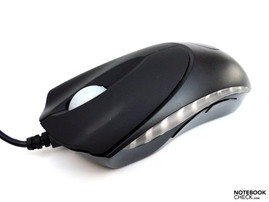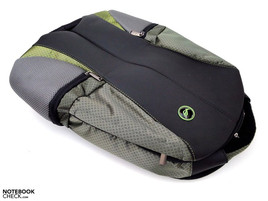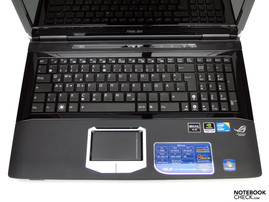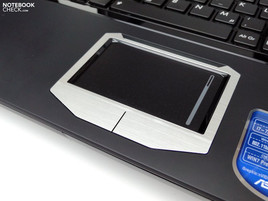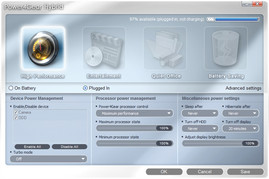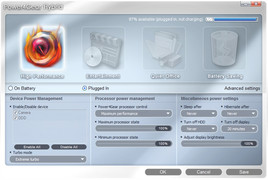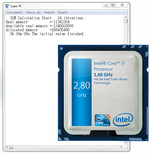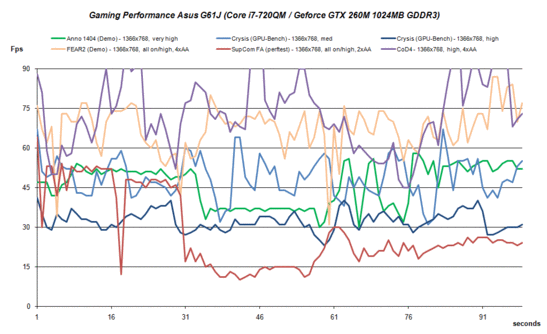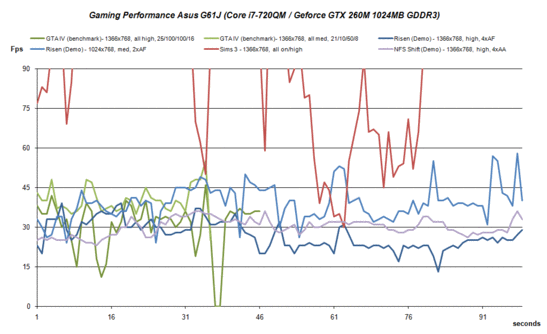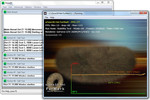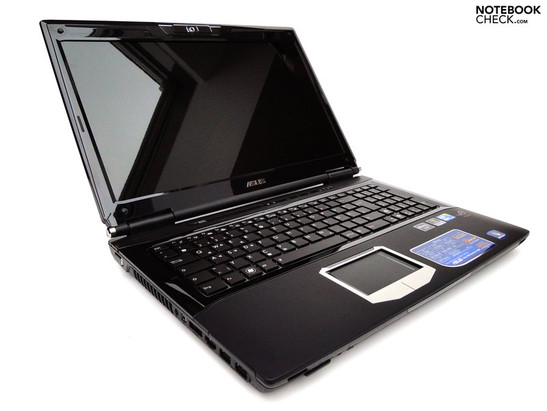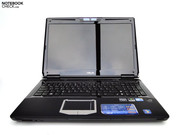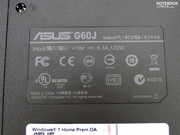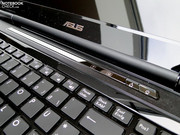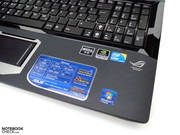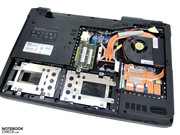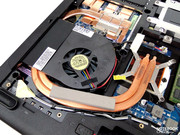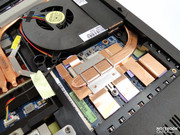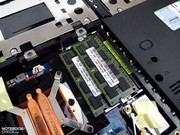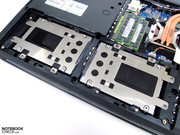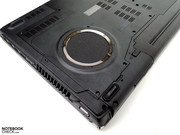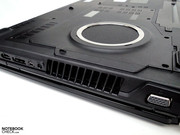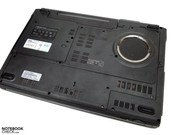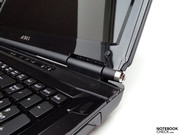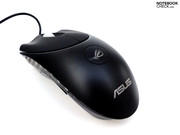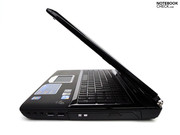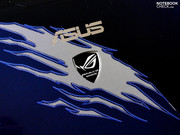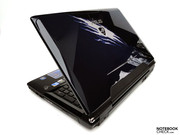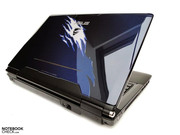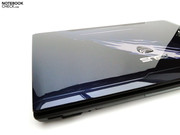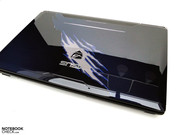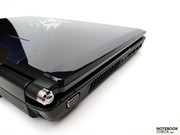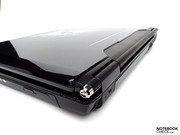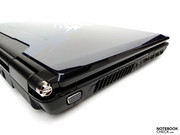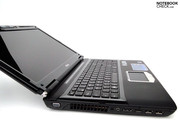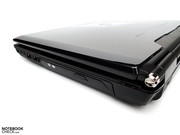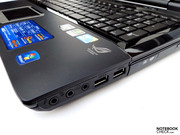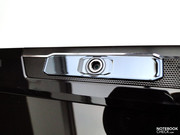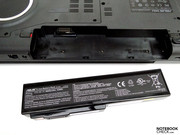Review Asus G60J Gaming Laptop
R.O.G. featuring Core i7.
"Republic of Gamers" is the brand name under which Asus has released a wide range of gaming laptops to meet the needs of enthusiastic gamers. As games become more realistic, they require higher performance from PCs and notebooks, thus requiring companies like Asus to constantly improve their gaming models by equipping them with newer and faster components. So it really comes as no surprise that the new Intel Core i7 CPUs are now being used for a wide range of Asus laptops. In our review: the Asus G60J equipped with the i7-720QM CPU and the GTX 260M graphics card from Nvidia.
As announced on the news, Asus recently presented the new gaming laptops in München. Included in this presentation were the G50J, with a 15.6 inch display, and the G60J with a 16 inch display, which we will examine in this review. Both models are equipped with the GTX 260M graphics card from Nvidia and a Core i7 CPU from Intel. The new Asus G72GX, which has the same graphics card but an "older" Dual-Core CPU, was also presented alongside the other two laptops. The models have an affordable price range of 1000 to 1700 euros, depending on individual customizations.
Case
Do you remember the first models of the Asus G-series? The G1 and G2, with all their different possible configurations were certainly "different" from the rest of the crowd of their time. They were colourful and shiny boxes, which did have a certain aesthetic appeal, but not much else to offer the buyer. Since then not only has Asus improved the performance of the gaming laptops but they have also altered the exterior of the models to make them seem more "mature".
The Asus G60J still has a few characteristics of the first G-models (for example, near the display hinges and the touchpad), but on the whole Asus' gaming models have changed a lot. Thankfully, their current gaming laptops no longer have as many blinking LEDs as the G1 or G2 models. Instead, Asus settled for an illuminated "Republic of Gamers" logo on top of the display case, and a small white and blue LED installed underneath the logo.
The back-lit keyboard is ergonomic and visually attractive. The light allows the user to be able to discern the characters on the keyboard even in a dark environment. The brightness level of the back-light can be easily altered, or, if the user so wishes, it can also be completely switched off, thus giving every individual user freedom of choice.
The material used for the Asus G60J is the same synthetic material which was used for older Asus gaming models. The only places where metal is used in the laptop are the hinges and the bordering of the touchpad.
Still the case gives an overall impression of high-quality, which is due, not only to the proven sturdiness of the notebook, but also to the combination of gleaming material around the keyboard and matt, velvety material in the hand-rest areas. This combination of two different materials is both visually attractive and practical as these materials prevent the laptops from accumulating a lot of fingerprints and smudges. However, the gleaming bordering of the display is a problem for two reasons: the first reason being that the display is a big magnet for ugly fingerprints and smudges, and the second reason is that the gleaming display might cause distracting reflections. However, next to the glare panel, this is the smallest evil.
Connectivity
Of course, a multimedia laptop has to have certain ports to earn that title. With a total of 4 USB ports, a HDMI port and an eSATA interface, the Asus G60J does offer a combination of ports which would suffice most users.
However, the placement of these ports can be problematic. Almost all the ports are near the front on the left and right side. Only the power outlet and the RJ45 LAN port are positioned on the rear of the laptop case.
As long as the buyer only uses two of the USB ports, it is possible to guide the wires around the laptop so that they do not restrict the space to the left or right of the laptop too much. However, when left-handed users connect an external monitor with the HDMI port then the space available to use on the left side becomes very small. Due to wires and sockets, navigating an external mouse next to the laptop can become impossible. Right-handed users have better luck as they only have two USB ports and a 3.5 mm audio port on the right side. If they arrange the wires properly, they can prevent the right side from being cluttered, and thus use an external mouse freely.
When it comes to communication, Asus has left no stones unturned. The G60J is equipped with Gigabit Ethernet from Atheros and a WLAN 802.11 b/g/n so as to allow the laptop to open both wired and wireless connections to the internet. Thanks to the integrated bluetooth, the notebook can also open up a wireless connection between itself and peripheral devices, such as, a mouse, a headset, or the user's mobile phones.
Included in the delivery package were a backpack and a mouse. The backpack seems to be of good quality, but we did not test it further. The mouse was a Copperhead from Razor, which is an actual gaming mouse. The shape of the mouse did require a bit getting used to, but there was nothing to complain about when it came to its precision and response time. The sensitivity of the mouse can be adjusted by pressing a button, which is really helpful when one wants to switch quickly in-game to "sniper mode".
The OS used for the laptop is the current 64-Bit Home Premium version of Windows 7. Asus has also issued a manufacturer's warranty period of 24 months for this product.
Input Devices
One of the special features of the Asus G60J is the back-lit keyboard. There are three different brightness levels for the keyboard so that the user can tone down or increase the illumination of the keyboard. In case, the buyer feels this is an unnecessary feature, he/she can just switch off the back-light. This special feature makes the keyboard visually attractive and easy to use in a dark environment, as the back-light illuminates the characters on the keyboard well enough to continue working with the lights out.
The layout of the keyboard is characterised by a roomy arrangement of each individual key, which basically means that the keys are arranged so that each key is at least a couple of millimetres away from the others. The size of an individual key is about 15x15 millimetres, which is smaller than the keys typically found in 16 inch notebooks. However, despite their smaller size, the keyboard is still easy to use with the 10-finger system.
The positioning of the keys is mostly conventional. However, there are a few exceptions. For example, the "delete" key is the fourth key from the right, and is positioned in the top row. However, if the user tries to press it without bothering to look closely then he/she might accidentally end up pressing the "print" or the "Pos1" key. In either case, pressing the wrong key would result in the notebook doing annoying and unnecessary things. However, gamers should not have any problems with this keyboard as the most important keys for them are clearly marked and positioned. For example, the "Ctrl" key is positioned in the bottom left corner of the keyboard, where it is commonly found. Even the A-W-S-D keys are clearly marked with arrows. This helps in recognizing them quickly and easily even when it is dark. Thankfully, unlike in the older models, Asus did not go overboard with colourful markings on the keyboard of the G60J.
It is a pity that, due to the alphanumerical keys right next to them, the cursor keys had to be reduced in size so as to be able to fit in. When using the cursor keys for racing games, the hand posture can become uncomfortable after a long while. An alternative to the cursor keys would be the numeric keypad to their right.
We were satisfied with the carefully arranged keys when typing due to their short stroke distance and their evident pressure points. While typing, the noise made by the keys is also rather comfortable.
Touchpad
The integrated touchpad is big and has a soft, velvety surface. All in all, the touchpad is a good alternative to an external mouse. The marking on the right side of the touchpad is a scroll zone. We could not discern whether or not the touchpad had a multi-touch ability.
The unconventional design of the touchpad keys reminds us strongly of the design of the earlier G-series models. Both keys are big and respond well to touch. The clicking noise is comfortable to the ear and the resistance offered by the keys is acceptable.
Display
Asus has equipped the G60J with a 16 inch display and a resolution of 1366x768 pixels (HD). This comes as no surprise as this is the current trend. However, the user must ask the question: Would it not be advantageous for me to have a gaming machine with a higher native resolution? One reason why a higher native resolution would be better would be that it would allow a better overview of the open windows, and thus allow the user to work more efficiently. Windows 7 can work better with the restricted desktop space than Vista, but WSXGA or WUXGA users will not be satisfied by just that.
Users who enjoy playing games would argue that a higher native resolution would actually do more harm than good on a gaming machine. This is because there is a trade-off between resolution and graphics details. Higher resolution usually means worse graphics details and slower performance in-game. So most gamers prefer setting the resolution lower and enjoying good graphics details and faster performance.
Unfortunately, there is no right answer to the above question. Due to the smaller space for rendition the display brightness lies in an acceptable region (maximum of 195 cd/m²). However, the distribution of brightness is not so good. In the top-right corner the brightness falls to 155.5 cd/m² which is an illumination of 79.7% compared to the maximum brightness of 195 cd/m². So on closer inspection, we concluded that the average brightness of the screen would be 173.6 cd/m², which pales in comparison to the original value and can, at best, only be considered an acceptable value.
| |||||||||||||||||||||||||
Brightness Distribution: 80 %
Contrast: 208:1 (Black: 0.83 cd/m²)
The quality of the picture is cast blue, which becomes more and more evident when the display is calibrated with the Spyder 3 tools. Even the colour richness could have been better despite the glare panel. The maximum contrast of the display is passable at best. The display manages to give a good contrast ratio of 208:1 with a black level of 0.83 cd/m².
The display will rarely be used outdoors as the Asus G60J works better next to an open socket on a desk than outside in the fresh air.
No matter where one uses the notebook, the user has to get used to the restricted viewing angle stability. Even a slight deviation along the vertical axis from the ideal perpendicular position can result in a distracting darkening, or brightening, of the picture. At least horizontally the picture stays stable longer, but even horizontally one has to be careful not to tilt the the display more than 30-40° at a time as this would result in colour change and strong reflections.
Performance
When we first tested models running Intel Core i7, the results we found indicated that the CPUs might be especially useful for gaming machines. The new CPUs combined the advantage of a high clock speed with the option of multiple cores, to be exact, four cores according to the current i7 series. Our comparison of the new Intel chips has led us to conclude that the i7-720QM has the best price/performance ratio among all the chips. So it was no surprise that the first Core-i7 based computers used it as the CPU.
The Asus G60J is one of the above-mentioned Core-i7 based computers, which combines the power of the 720QM chip with the Geforce GTX 260M from Nvidia. This is definitely a combo which can deliver good performance, even if it's not high-end performance. However, the price/performance ratio is very good so it is worth the buy. The top price of 1700 euros is relatively low when compared to that of the new Alienware m15x. The Asus G60J manages to hold its own against the alienware laptop for a much lower price. Of course, it lacks the "show" factor of the alienware models, which makes them so desirable, however, it still performs well.
What else does the G60J have to offer? Well the notebook is also equipped with four Gigabyte DDR3 RAMs from the factory. Each RAM stick has a memory of 2 GB and the two modules are split up into two pairs which are used in Dual-channel mode so as to get a bit more performance out of them.
The combination of two 500 GB hard disks from Seagate (Momentus ST9500420AS) is another significant feature of the laptop. So in total the laptop has a high-quality storage space of 1 TB (terabyte) which runs at 7200 rpm. When we ran the HDTune benchmark we found out that the hard disks can transfer data at up to 101 MB/sec and have an access speed of 17.2 milliseconds.
Well, that should be enough dry technical details. So let us compare the Asus G60J with other notebooks so as to make it clear how good it really is. During the presentation, Asus proclaimed that the G60J managed to score 11,000 points on the 3D Mark 2006 Test – a very good result. So we decided to confirm this fact and ran the 3D Mark test with a resolution of 1280x1024 pixels. We found a result of 10084 points which is less than what Asus had announced (running at its native resolution of 1366x768 pixels), but it still was above the 10k line. With such a good performance, it should be possible to play current games with a good resolution and high graphics details.
With the above result, we can conclude that the Asus G60J performs on the same level as the Clevo M570TU with the 9800M GTX graphics card, the Thinkpad W700 with the Quadro FX 3700M graphics card, or the mySN XMG5, which is also equipped with a GTX 260M graphics card. The next hurdle for the Asus G60J would be the 12k points line, but that line is far out of its reach with the performance of its current components. That hurdle can only be crossed by machines equipped with a GTX 280M graphics chip from Nvidia or an extensive Crossfire-combo from ATI.
| 3DMark 06 Standard Score | 10199 points | |
| 3DMark Vantage P Result | 4900 points | |
Help | ||
The second method to ascertain the gaming power of the Asus G60J is to run the current 3D Mark Vantage benchmark. In this case, the PhysX was deactivated so as to be able to compare the results to that of ATI systems, as that feature of the graphics card can influence the result and make it higher than it actually is. The G60J from Asus scores 4900 points and thus positions itself right next to the mySN XMG5 and lies about 500 points behind the GT725 from MSI (ATI Mobility Radeon HD 4850 / Intel P9500).
To see how well the laptop performs with programs, we ran the PC Mark Vantage benchmark, which is also from Futuremark. With a total score of 6199 points, the Asus G60J manages to beat many gaming machines. In this case, the superiority of the Quad-Core CPU becomes evident, especially that of the new i7 chip. Only the mySN XMG7.c, which is equipped with the i7-820QM CPU, can beat the Asus G60J with its score of 6704 points. An exception to the above statement would be the mySN QXG7 with an Intel 975 Desktop Core i7 which performs at a similar standard. The Alienware m17x with the QX9300 CPU and the GTX 280M SLI graphics card lies defeated with 5422 points.
| PCMark Vantage Result | 6199 points | |
Help | ||
Asus Power 4 Gear Turbo Mode
For a long time now Asus has been integrating the option to overclock the CPU with the press of a button into their gaming models. To overclock the CPU in the Asus G60J, one has to first find the right program. It sounds easy but finding the program itself was a hard task.
The program is called "Power 4 Gear" and with it the user can assign specific performance modes to certain keys. By doing so, it becomes easier to switch between modes as one has to simply press the button for the mode that one wishes to use. Additionally, under the option "Turbo Mode", one can overclock the CPU. Once pressed a picture appear with the logo: "High Performance" in flames.
The technical details of the i7-720QM CPU proclaim that the CPU can run on a range from 1.6-2.8 GHz. The speed at which the CPU runs depends on the computing power and the cooling available. Further details can be found here: Intel Core i7 special report.
In the SuperPi benchmark, which is supposed to get the maximum clock speed of a CPU by using a single core, we found that the Intel Turbo Boost widget can only get a maximum clock frequency of 2.4 to 2.8 Ghz when the Asus Turbo mode is deactivated. However, it seems to fluctuate a lot. When the Turbo mode is activated ("Extreme Turbo"), then maximum clock frequency lies between 2.67 and 2.8 Ghz. Most of the time, however, the CPU stays at 2.67 Ghz.
Thanks to the results the increase in performance due to the turbo function is clear: 858 seconds in 32m test and 822 seconds with the activated turbo mode. This shows that the turbo mode boosts performance by at least 4%.
If one looks at the boost in performance from the turbo function, when running a benchmark which focuses on graphics, like the 3D Mark 2006, then one can see that the boost is, as expected, smaller. The performance increase is about 1.14% which is exactly 115 points. The positive increase in performance in-game from the turbo function is almost negligible.
We could not achieve the rumoured 3.0 GHz clock speed of the Core i7-720QM in our overclocking tests when using the overclocking function offered by Asus. The Intel Turbo Boost widget managed a maximum of 2.8 Ghz, and even that kept fluctuating, just like in our i7 - test configuration. So one could conclude that the Asus G60J does not have enough cooling to unlock the full potential of the i7 CPU.
Gaming Performance
Using generic benchmarks to ascertain the performance of the Asus G60J is good, but it is better to actually test the laptop by running current games on it. To this end, we chose a handful of current games, and a couple of "classics" to run on the G60J. The following are the results we gathered.
Anno1404
This strategy game from the Anno series performs very well on the G60J. We played the demo version of the first campaign and set the graphics details and resolution at the highest level. The result is as follows: the FPS (frame rates per second) was constantly above 30 fps, and thus we can safely proclaim that the game performed smoothly on the laptop.
FEAR 2
We ran the horror shooter FEAR 2 at maximum resolution and high graphics details (all the options turned on and 4 x anti-aliasing). The performance was amazing: The game ran on average at 67.48 fps and, although there were a few times were the frame rates per second dropped under 30 fps, we did not experience any interference with the game.
Crysis
We chose this game for two reasons: the first being that it a lot of gamers love playing it and the second reason is that it is very demanding on the computer components. Even though it has been years since its release, this game is still considered a major hurdle in performance for gaming laptops and PCs.
We tested the game on the Asus G60J at its native resolution (1366x768) and middle and high graphics details. At medium details, the integrated graphics benchmark showed us a result of 48,36 Fps, which is good. However, at high details the performance fell to about 30 fps. Although the game still ran somewhat fluidly, it would be recommended that the user set the graphics at medium as later at this level there were many interferences with the game.
Supreme Commander -Forged Alliance
The strategy game "Supreme Commander" could be described as: Real-time battles in the air, the water and on the land, on maps which are up to 1600 km² big. This means a lot of work for both the graphics card and the CPU which have to manage and display hundreds of units locked simultaneously in combat.
Fraps kept a log of the performance benchmark which is integrated in the game. This benchmark simulated a multiplayer game, and we found that, depending on the level of zoom, the game ran at 15-45 fps. Still the game ran somewhat fluidly and it is possible to reduce the graphics details and have a good performance even at full zoom.
Call of Duty 4 – Modern Warfare
The next game in the modern warfare series is about to be released. Till then, thousands of gamers all around the world will continue to enjoy this game, especially when using the online multiplayer option.
Even this game was not a problem for the Asus G60J, which managed to run it at a constantly above 45 Fps, even when the graphics details were set at high (maximum resolution of 1366x768, all options on, and 4xAA). In the first single player mission the game ran, on average, at 74,93 fps.
Grand Theft Auto IV
The producers of GTA IV pulled all the plugs for this newest addition of the GTA series. At the time of its release, only the absolute high-end laptops were able to run this game. Now, the affordable middle-class notebooks are finally catching up and are able to run this game at a medium graphics level.
At medium graphics details, the integrated benchmark showed that the game would run at a playable 40,62 Fps. When the graphics details was increased, the frame rates dropped to 0-15 fps, which was definitely a very distracting lapse in performance.
Risen
"Risen" is a hit role-playing game, so we decided to run the demo on the Asus G60J to see how well it performs on the notebook. Unfortunately, the result was quite similar to that of GTA IV. At high graphics details, the performance was unsatisfying. Only after we reduced the graphics settings did the performance increase to 30-45 fps, which is necessary for the game to be playable.
The Sims 3
The "Sims" ran without any problems on the G60J. Even at the highest graphics level, the game ran smoothly. "The virtual puppet house is now open..."
Need for Speed - Shift
The newest addition to the "never ending" NFS series is named "Shift", and promises a thrilling racing experience. Of course, to support such a claim, the graphics would have to be quite high too. The Asus G60J managed to run the test rounds on the "London" course of the demo with an average of 30 fps (at high graphics details). As the frame rates per second stayed above 25 fps, we experienced no distracting jerks in the demo.
By reducing the graphics details to medium and the resolution to 1024x768 pixels, the game ran at a somewhat higher 33.6 fps.
Summary: Thanks to the restricted maximum resolution of the display, the user can easily play most of the current games with good graphics details. So at the native resolution of 1366x768 pixels, it should be possible to play current games with middle or high graphics details. That will suffice for most gamers, however, one or two strategy games could have had a better overview with a higher resolution.
System Noise
The constantly running cooler fan of the Asus G60J is something that every user will just have to get used to. Even when the laptop is not under heavy CPU usage, the system noise level is at about 36.2 dB(A), which is still bearable. Sometimes, when in office use, the noise emission can increase to 39.8 dB(A).
After running the Asus G660J for a few hours, the maximum system noise level rises to a maximum of 49.1 dB(A). When playing games, the noise level rises to a minimum of 47.8 dB(A). At these levels, the laptop can be described as loud, even though the speakers can drone out the system noise if turned up. However, in a quiet environment, the notebook will be uncomfortably loud.
Noise level
| Idle |
| 36.2 / 36.2 / 39.8 dB(A) |
| HDD |
| 36.4 dB(A) |
| DVD |
| 38.9 / dB(A) |
| Load |
| 39.8 / 49.1 dB(A) |
 | ||
30 dB silent 40 dB(A) audible 50 dB(A) loud |
||
min: | ||
Temperature
Without heavy CPU usage, the case of the Asus G60J can warm up to an acceptable level. On the surface above the left keyboard region, the maximum temperature reached was 33.7 °C. The underside of the notebook can reach a somewhat higher 39.5 °C, which is still acceptable.
Under heavy CPU usage, the situation rapidly exacerbates. The highest temperature on the surface of the laptop can rise to 41.6 °C and the underside can reach a maximum of 51.6 °C which is substantially higher. Still if the laptop is being used as a desktop replacement notebook then these values should not be a problem.
The temperature inside the case is a lot higher. The graphics card can reach up to 95 °C when under heavy usage (Furmark), and thus is very close to the maximum operating temperature of the Nvidia graphics chip. In any case, one should ensure that the cooling vents are always clean and open, as at this temperature the Asus G60J is already pushing the limits without any reserves.
(±) The maximum temperature on the upper side is 41.6 °C / 107 F, compared to the average of 40.4 °C / 105 F, ranging from 21.2 to 68.8 °C for the class Gaming.
(-) The bottom heats up to a maximum of 51.6 °C / 125 F, compared to the average of 43.3 °C / 110 F
(+) In idle usage, the average temperature for the upper side is 30.8 °C / 87 F, compared to the device average of 33.9 °C / 93 F.
(+) The palmrests and touchpad are reaching skin temperature as a maximum (35.8 °C / 96.4 F) and are therefore not hot.
(-) The average temperature of the palmrest area of similar devices was 28.9 °C / 84 F (-6.9 °C / -12.4 F).
Loudspeakers
The intake of air on the underside of the laptop resembles a huge subwoofer, however, after using the speakers once we found out that we were sadly mistaken. The sound coming from the speakers on the left and right sides above the laptop can't reach high volumes, and thus the sound quality is weak and baseless. The maximum volume is really not that high, and the supposedly cool sticker of EAX from Creative Labs which comes along with the laptop really does not help. When playing computer games, or playing a DVD, we highly recommend using external speakers or a high-quality headphone set.
Battery Life
Although, the minimum requirements of a gaming notebook are very accommodating, the Asus G60J still fails to meet the minimum standard set for battery life. In the BatteryEater Readers test, we found out that the maximum possible run time of the laptop (when the energy saving mode is switched on, that is, with all unnecessary communication modules switched off and minimum display brightness) is 85 minutes.
Although that's already bad enough, it just gets worse: Under heavy CPU usage, in the BatteryEater Classic test, the laptop only lasted for a weak 38 Minutes. Seeing these results, we decided to skip the additional tests which are supposed to test how long the battery would last when the laptop was used solely for surfing with the WLAN, or playing a DVD. If lucky, the minimum amount of time the battery would last in those two cases would be one hour.
It would be good to mention at this juncture that we had multiple problems when we were trying to test the battery life of the G60J. When we removed the power chord from the laptop, the G60J kept crashing, and only started up after the battery was taken out and put back in. However, we believe that this was due to a contact problem in our test model.
One look at the energy consumption of the notebook confirms that the measured values are correct when compared with the capacity of the battery (53 Wh). When used for office use, the laptop required about 40-50 W. When running games, the laptop consumes above 100 W. The maximum energy consumption we measured was 119 W.
| Off / Standby | |
| Idle | |
| Load |
|
Key:
min: | |
Verdict
In our review, the Asus G60J showed a lot of its good side. The well-designed case, which is visually attractive and gave the impression of good quality, the good assortment of ports, and the input devices, which allow the user to work comfortably hours on end on the notebook, are all good features of the Asus G60J. However, there were also a few minor flaws, such as, the placement of the ports, which could be really problematic as the wires could clutter the workspace, and thus prevent the user from being able to use an external mouse.
Later on, while we were testing the display, we found the first major flaw in the G60J. The native resolution of 1366x768 pixels (16 inch) is too low for some users, especially when there are multiple windows open. Another weak point would be the stability of the viewing angle. Even though this laptop is intended as a mobile desktop replacement, the viewing angle stability is just too weak.
In our performance test, the notebook showed us that it also has a few other strengths which we did not mention above in the first paragraph. Here, the laptop performed very well in both benchmarks and practical gaming use. Thanks to the low native resolution it is possible to play current games with high graphics details.
Wireless mobile use? That is definitely not recommended. With some luck, the G60J could manage to run about a hour on a full battery, and this is of course only the case if the G60J is energy-saving mode. The use of the integrated battery alone should thus be reserved for emergencies, like, for example, a sudden blackout. At times like that, it would be helpful to have the battery to be able to save your precious work and turn off the computer.
All in all, the Asus G60J is a good gaming laptop even if it has a few major flaws. However, every individual buyer must ask themselves the question: is it worth paying 1700 euros for? The gaming laptops market is constantly growing, and the Acer multimedia laptops are not the only ones which can offer good performance at a reasonable price. So, one thing is clear. the competition among low-cost gaming laptops is fierce. A few examples would be: the MSI (GT640/GT740), or Acers new multimedia notebooks (Aspire 5940G(8940G)), which are all equipped with the brand-new Nvidia GTS 250M graphics card, and can be expected to deliver an extra bit of performance. Even the Alienware M15x lies near the price range of the Asus G60J.









